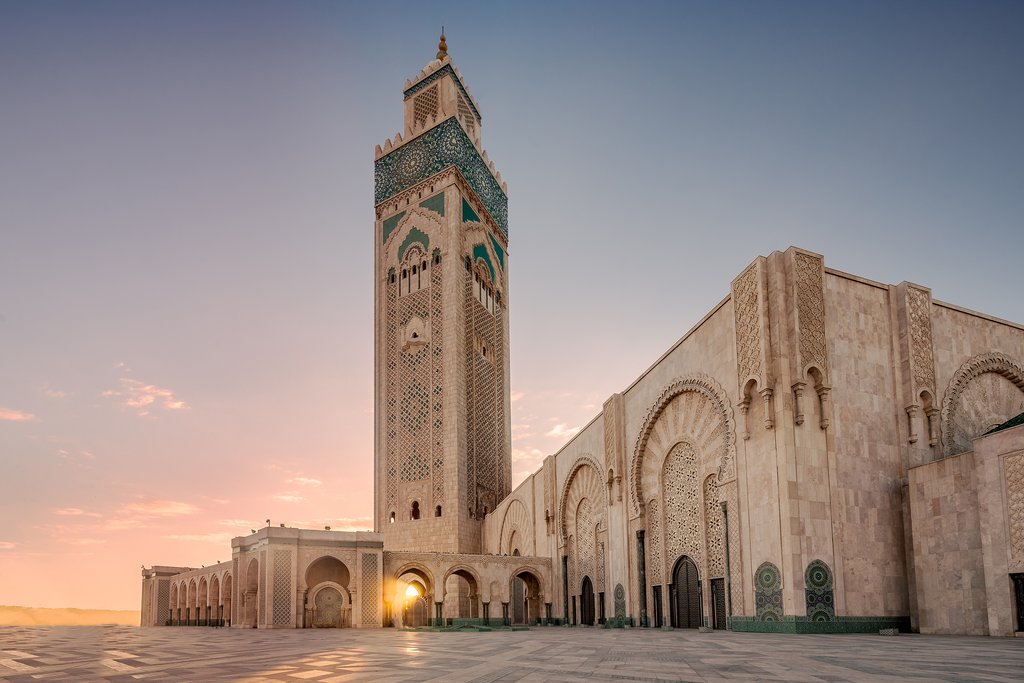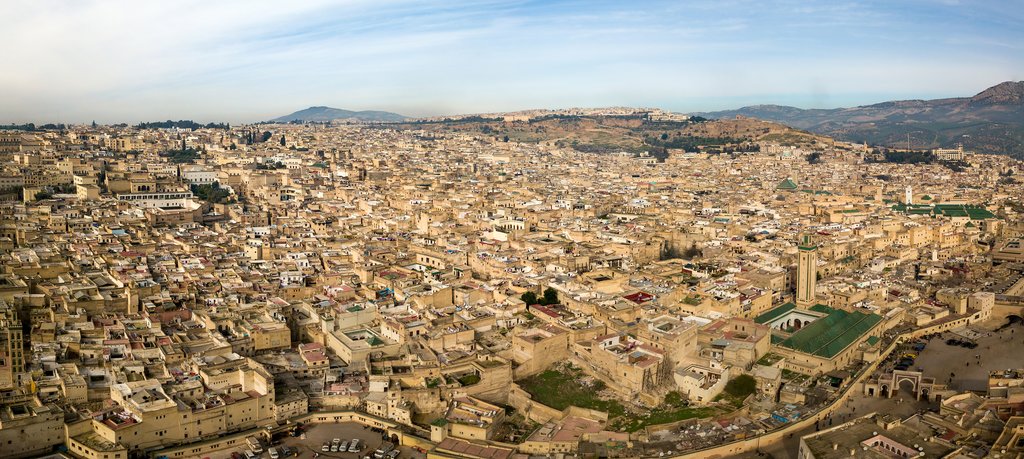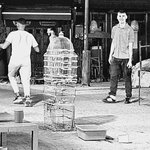Highlights
- Discover souks, tanneries, and artisan workshops in medieval Fes
- Explore sand dunes, oases, hidden valleys, and old kasbahs in the desert
- Watch dancers, henna artists, and acrobats in animated Jemaa el-Fna
- Climb ramparts overlooking the Atlantic and eat fresh seafood in Essaouira
Brief Itinerary
| Day | Highlights | Overnight |
|---|---|---|
| Day 1 | Arrive in Casablanca, Transfer to Rabat | Rabat |
| Day 2 | Transfer to Chefchaouen, Explore the Blue City | Chefchaouen |
| Day 3 | Transfer to Fes via Volubilis & Meknes | Fes |
| Day 4 | Explore the Medieval Medina of Fes | Fes |
| Day 5 | Transfer to Merzouga & Erg Chebbi, Overnight at a Desert Camp | Erg Chebbi |
| Day 6 | Transfer to Ouarzazate via Desert Towns & Oases | Ouarzazate |
| Day 7 | Transfer to Marrakesh via Aït Benhaddou & Tizi n'Tichka Pass | Marrakesh |
| Days 8-9 | Marrakesh: Exploring the Red City | Marrakesh |
| Day 10 | Transfer to Essaouira: Seaside Ramparts & Fresh Seafood | Essaouira |
| Day 11 | Return to Marrakesh, Depart |
Detailed Itinerary
Day 1: Morning in Casablanca, Transfer to Rabat

Welcome to Casablanca! If you only visit one place in Casablanca—the commercial capital of Morocco—make it the Hassan II Mosque. Sitting in a picturesque location on the ocean, its 690-foot (210 m) minaret is the tallest minaret in the world. While the exterior and surrounding area are impressive, what makes this mosque even more unique is it is one of the few mosques in the country where non-Muslims are permitted to enter. Join a morning tour of the mosque and marvel at the fine artisanship: hand-carved stone and wood, intricate marble floor detailing, and gilded ceilings.
Venture north to the imperial city and present-day capital of Rabat (Meknes, Fes, and Marrakesh are the others). Explore the medieval fortification of the Chellah Necropolis and wander the Roman and Islamic ruins. Enter through the grand door of the Kasbah des Oudaias into Rabat's old city center. From there, visit the 20th-century Andalusian Gardens and enjoy the serene space away from the crowds. Discover the Hassan Tower, a minaret of the incomplete mosque and Mausoleum of Mohamed V. A 12th-century project that was abandoned where all that remains are the minaret and some 200 columns.
Day 2: Transfer to Chefchaouen, Explore the Blue City

This morning, head north to the striking blue city of Chefchaouen in the Rif Mountains. Just before you reach Chefchaouen, stop to hike (2-3 hours) through lush vegetation and small pools to enjoy the Cascade d'Akchour (Waterfalls of Akchour)—a hidden gem. From there, arrive in charming Chefchaouen. Mostly untouched since the 15th century, Chefchaouen offers a relaxed atmosphere with some of the friendliest people in the country and is known for its blue-washed buildings in its historic medina (old quarter). Explore its narrow streets and alleyways, which cling to the northern hillside of the mountains.
Discover Plaza Outa el-Hammam, the main square named for the number of hammams (public baths) that used to encircle it. Find a restaurant or café for a bite to eat before browsing the many shops offering traditional wares. Visit the Grand Mosque and Kasbah (old fortress or fortification) and tour the Kasbah's garden, museum, and even some of its old prison cells. As the evening approaches, ascend the path leading to the abandoned white Spanish Mosque (20 to 30 minutes) to enjoy one last view over Chefchaouen as the sun sets behind the mountains.
Day 3: Transfer to Fes via Volubilis & Meknes

Meet your driver and head south toward Fes. Along the way, stop and stretch your legs to visit the Roman ruins of Volubilis. A UNESCO-protected site founded in the third century BCE, it remains incredibly well-preserved. From there, stop to explore Meknes. A smaller version of Fes, Meknes offers a calmer medina, and shopkeepers are not as pushy to make a sale. While Meknes is quite large, the two main areas of interest are the Ville Impériale (imperial city) and the manageable medina. Be sure to check out the grand Bab al-Mansour gate and the Mausoleum of Moulay Ismail.
Carry on eastward to Fes. Before venturing into the medina with your driver, drive up the hill to spend some time wandering the ruins of the Merenid Tombs for an all-encompassing view of the medieval city. The best time to visit the tombs is around dusk. The muezzin's calls to worship can be heard through the valley as the city lights begin to glow, adding to the atmosphere. Return to your traditional riad for a warm meal and settle in for the evening.
Day 4: Explore the Medieval Medina of Fes

The oldest of the imperial cities in Morocco and perhaps the most interesting and exciting to explore, Fes has undergone little colonial development, adding to its medieval appeal. The most complete medina in the Arab world and a UNESCO World Heritage site, Fes is made up of three main points of interest: Fes el Bali (old Fes, the medina, and where you will spend most of your time), Fes el Jdid ('new' Fes), and the French-influenced Ville Nouvelle. Meet your guide to learn more about the history and culture of Fes and, most importantly, to help you navigate the medina.
Begin your tour in Fes el Bali, starting at the Bab Boujeloud gate, welcoming you onto Talâa Kebira. Discover the wares for sale in the souks (markets) and shops as you pass the Spanish and Tunisian-influenced architecture. One of the most unique sights in the old Medina is the tanneries, and Chouara Tannery is no exception. Next, climb to the rooftop of a nearby leather shop for a better view of the 11th-century stone pots filled with dye and men working. Follow your guide to Al-Qarawiyyin Library and Mosque (859 CE). If you're lucky, you may be able to sneak a peek inside the Library.
Chat with a local specialist who can help organize your trip.
Day 5: Transfer to Merzouga & Erg Chebbi, Overnight at a Desert Camp

You'll be covering a lot of ground today as you work your way south toward your final destination outside the desert town of Merzouga. Ascend the Middle Atlas mountains through fragrant cedar forests and over the Col du Zad pass. Stop and stretch your legs in the "Apple City" of Midelt—known for its fruit orchards—and lunch near the Moulouya River. Continue to the palm forests of the Ziz Valley by way of the Tizi n'Talremt pass, noting the many fortified ksars merchants built to protect and stock their precious goods (gold, salt, and spices).
Reach Erfoud, known for dates and fossils, and stop at a local artisan collective to learn everything there is to know about the types of fossils found in the area. Head toward the sea of sand of Erg Chebbi, where some dunes are more than 600 feet tall. In Merzouga, meet your camel and hop aboard to trek to your evening's accommodation: a Bedouin-style tent. Race to the top of a nearby sand dune to watch the desert sunset over the dunes before returning to your site for dinner and a campfire under the starry night sky.
Day 6: Transfer to Ouarzazate via Desert Towns & Oases

Catch the sunrise before renting a sandboard to test your skills. Leave the dunes and head to Khemliya to experience a traditional Saharan village—its people originally from Mali. Continue west to pass through a dramatic gate into Rissani. A market town, Rissani holds a livestock auction and is home to a "donkey parking lot," a site worth (hearing) about and experiencing! Make your way to the desert town of Tinghir before reaching the 984-foot (300 m) deep Todra Gorge. You will have time to explore the gorge and relax in the cool water of the shallow Todra River.
Travel through the Valley of a Thousand Kasbahs. Though many kasbahs are now in disrepair, local families still live in some of them. You may even come across nomads herding their animals. Head west to Kelâat M'Gouna. Known for its Festival des Roses, here you can see extensively cultivated farmland bordered with fragrant rose bushes. Continue west to Ouarzazate, a gateway to the Sahara Desert made popular by the film industry. Join a studio tour and discover how the nearby desert landscapes have been featured in many films.
Day 7: Transfer to Marrakesh via Aït Benhaddou & Tizi n'Tichka Pass

Travel to nearby Aït Benhaddou. A UNESCO World Heritage site, Aït Benhaddou is believed to date from the 11th century, during a time when it held an important position along the trans-Saharan trade route between Marrakesh, Ouarzazate, and the southern desert. Follow the narrow streets up to the Granary for a view of the surrounding landscapes before leaving Aït Benhaddou behind to begin the ascent over the High Atlas mountains—spot Mount Toubkal, the mountain range's highest peak, at 13,671 feet (4,167 m). Stop in Taddert to visit an argan Oil Cooperative and learn how the argan nut and fruit are processed for various uses.
As you descend the High Atlas, you will notice a dramatic change in the climate and landscape. Soon, you will be a part of the noise and clamor of Marrakesh. After a long day on the road, settle into your hotel and spend the rest of the afternoon as you like. In the early evening, the main square—and busiest square in all of Africa—Jemaa el-Fna, comes alive with musicians, performers, snake charmers, games, and food stalls, a catch-all of entertainment. If you want to enjoy the spectacle from a distance, choose one of the many cafés surrounding the square and enjoy a cup of mint tea and a meal.
Days 8: Marrakesh: Exploring the Red City

Nicknamed the "Red City" for its 1000-year-old red sandstone city walls and buildings, Marrakesh is a major economic center. Marrakesh has Berber rather than Arab roots and was once an important trading capital for tribes of the Atlas mountains. Orient yourself around Marrakesh's bustling Jemaa el-Fna Square: the souks are to the north, the Koutoubia Mosque and gardens to the west, and the Kasbah area with the Saadian Tombs, Bahia Palace, and El Badi Palace are to the south. In the Ville Nouvelle, you will find the Majorelle Gardens.
For a unique way to tour the medina, board a calèche (French for horse-drawn carriage) and begin to adjust to your surroundings. Notice the fondouks—medieval inns that provided merchants and travelers with shelter and supplies. Today, some have been converted into residences or large shopping areas and workshops that you can explore. Find your way to the Koutoubia Mosque and take a respite from the heat in its gardens amid fountains and palms. Though the mosque cannot be entered by non-Muslims, it's worth checking out its 12th-century foundations and minaret.
Day 9: Marrakech: Palaces & Souks

Meet your guide for a half-day tour and discover the exquisite details of the Ben Youssef Madrasa School of Islam for a taste of 16th-century architecture. Admire the traditional Moroccan artisanship: carved cedar, sculpted plaster, arabesques, Islamic calligraphy, and colorful zellij (mosaic tilework). Wander the old dorms where up to 800 students once lived and visit the prayer hall.
Spend time exploring the Dar Di Said Museum (also known as the Museum of Moroccan Arts) to see exhibits of clothing, antiques, jewelry, and beautifully carved Hispano-Moorish decorations. Afterward, indulge your senses as you explore the complicated labyrinth of souks tucked behind ordinary restaurants and shops. Check out Souk el Attarin, Souk Chouari, and Souk Smata for a selection of spices, woodwork, and babouche (traditional Moroccan slippers). Visit Souk des Teinturiers (the dyers souk) to see firsthand how leather hides and cloth are dyed.
Day 10: Transfer to Essaouira: Seaside Ramparts & Fresh Seafood

Leave the busy city behind and make your way west to the Atlantic coast and to the laid-back beach town of Essaouira. The route along the way takes you over extensive rolling plains and through endemic argan forests. If you're lucky, you may see goats in the trees grazing on the argan fruit, a sight seen when grass pasture is limited or unavailable.
Arrive in the port city of charming Essaouira, a nice contrast to frenetic Marrakesh, and spend the rest of the day as you choose. Walk the Skala de la Kasbah (the 18th-century seafront ramparts) along the coast. Designed by European engineers, old brass canons line the walls and offer viewing access over the Atlantic. Explore the UNESCO-protected medina before making your way to the windswept beach. Jimi Hendrix fans may want to take a short taxi ride to Diabat at the end of Essaouira's beach, where he reportedly spent some time. Walk back to Essaouira and enjoy a meal of freshly caught seafood.
Day 11: Return to Marrakesh, Depart

Known as the "Windy City" for its strong Alizée trade winds that hit its crescent beach, Essaouira is a popular kiteboarding destination. Take the morning to watch the windsurfers and kiteboarders, or for the more adventurous, take a lesson before saying goodbye and returning to Marrakesh.
Depending on your flight details, you may wish to explore the Kasbah area south of Jemaa el-Fna. Check out the Saadian Tombs and discover the 500-year-old craftsmanship that went into its construction. Visit the sunken gardens of the 17th-century El Badi Palace as you work your way through the Mellah (Jewish quarter) and to the 19th-century Bahia Palace. Visit the only surviving Almoravid monument, the 12th-century Almoravid Koubba, before spending some time in the Marrakesh Museum, housed in the 19th-century Dar Mnebbi Palace, and enjoy modern and traditional Berber and Moroccan art.
More Great Morocco Itineraries
Looking for more inspiration for your trip to Morocco? Check out these other Morocco itineraries, explore different ways to spend 11 days in Morocco, or discover the best time to visit Morocco.








